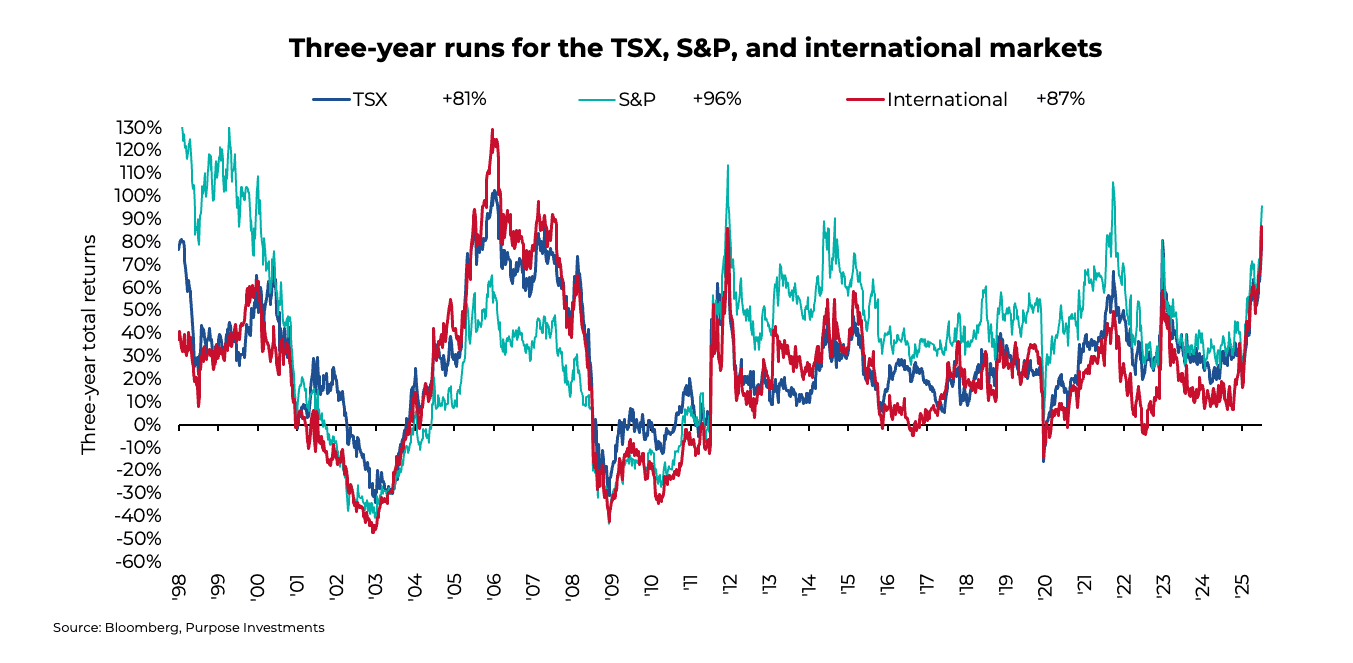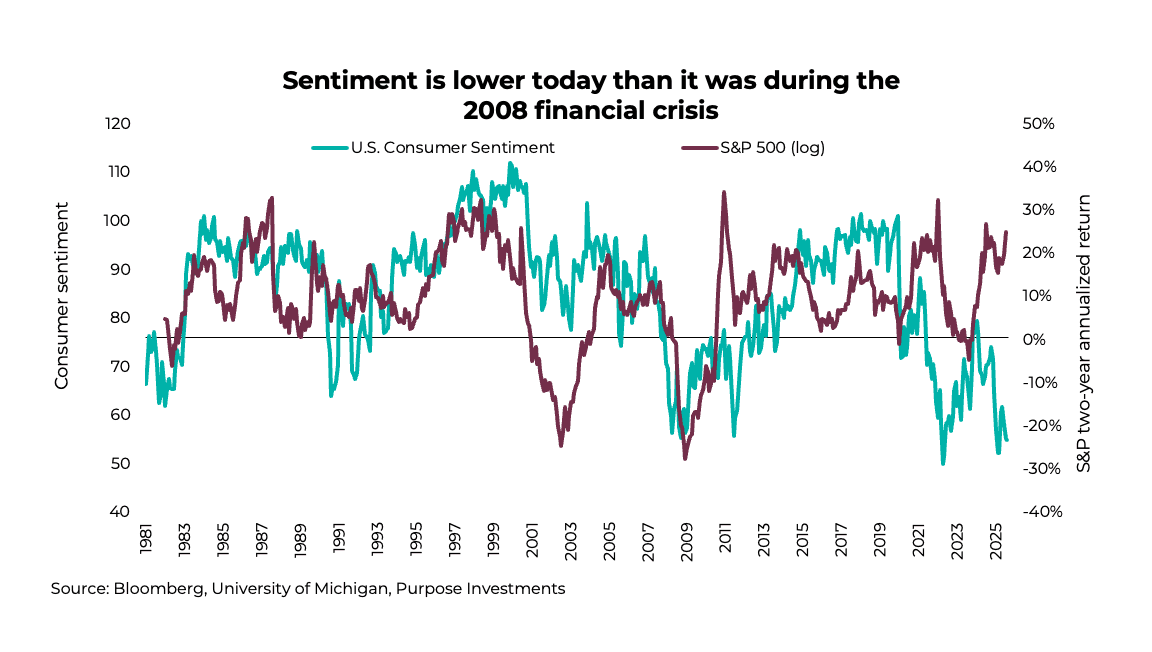What a year! The TSX is near the top of the global market leaderboard, up +25% and the Blue Jays are into the American League Championship Series. If you can get over the tariffs, the economy nearing stall speed, the macro uncertainty, and the general grumpiness that seems to be impacting most populations, otherwise it’s been a great year.
Perhaps the most recurring question we receive is: how are markets up so much and, more importantly, can it keep going? This may be an opportune time to let the Blue Jays provide some guidance.
Just because something goes up doesn’t mean it has to come back down. However, when markets move in a big way, there is often a gravitational pull or reversion to the mean that could cool future return expectations. The chart below captures the issue, looking at the three-year trailing total return of major equity markets. A three-year gain of +81% for the TSX, +96% for the S&P and +87% for international markets is remarkable. As you can see, there have been returns higher than this, but never in the past 25 years have all three simultaneously been over 80%.

Just because the market is up a lot doesn’t mean it can’t keep going, but we believe we’re in somewhat uncharted territory. As we highlighted in a recent Ethos, some solid macro fundamentals are driving or supporting this market advance and resilience. Those include improving economic data, as well as inflation not accelerating, which allows bond yields to come down and helps multiple expansion. And revisions have ticked higher as we head into earnings season, with the last two having a higher proportion of positive surprises compared to the norm. Still, this advance is pretty extreme at this point.
Perhaps even more puzzlingly, nobody is happy. There was a time when strong equity markets made people celebrate, but that doesn’t seem to be the norm anymore. The University of Michigan Consumer Sentiment captures consumer attitudes towards personal finances, general business conditions, and market conditions. This survey has historically tracked well directionally with the S&P 500. The puzzling aspect is that, with markets up so much, why is consumer sentiment worse than during the depths of the financial crisis?

We’re not saying the world is perfect, but it isn’t as dire as sentiment would imply. Rising markets just don’t make people as happy as they used to. This is a cautionary signal for markets.
Final Thoughts
Back to baseball: the Jays had the lowest strikeout rate this year at 6.8 per game, and we believe this is the strategy investors should tilt towards after such strong gains. This isn’t the time to try and swing for a homer or even a double; the goal should be to avoid striking out. Give us a single or a walk.
So what does that mean for portfolios? Well, we all want markets to continue moving higher, and that may occur. However, if history holds, the risks may have turned up, not because the news has necessarily gotten worse, but simply because the gains have been so strong.
We believe in tilting more to strategies that will deliver a nice single on top of already realized gains if this rally does continue. Those more defensive plays should have a lower risk of striking out or giving back too much of the gains in case market gravity kicks in.
— Craig Basinger is the Chief Market Strategist at Purpose Investments (special thanks to Jeff Gans from Advisor Solutions by Purpose for the baseball analogy idea).
Get the latest market insights in your inbox every week.
Sources: Charts are sourced to Bloomberg L.P.
The content of this document is for informational purposes only and is not being provided in the context of an offering of any securities described herein, nor is it a recommendation or solicitation to buy, hold or sell any security. The information is not investment advice, nor is it tailored to the needs or circumstances of any investor. Information contained in this document is not, and under no circumstances is it to be construed as, an offering memorandum, prospectus, advertisement or public offering of securities. No securities commission or similar regulatory authority has reviewed this document, and any representation to the contrary is an offence. Information contained in this document is believed to be accurate and reliable; however, we cannot guarantee that it is complete or current at all times. The information provided is subject to change without notice.
Commissions, trailing commissions, management fees and expenses all may be associated with investment funds. Please read the prospectus before investing. If the securities are purchased or sold on a stock exchange, you may pay more or receive less than the current net asset value. Investment funds are not guaranteed; their values change frequently, and past performance may not be repeated.
Certain statements in this document are forward-looking. Forward-looking statements (“FLS”) are statements that are predictive in nature, depend on or refer to future events or conditions, or that include words such as “may,” “will,” “should,” “could,” “expect,” “anticipate,” “intend,” “plan,” “believe,” “estimate,” or other similar expressions. Statements that look forward in time or include anything other than historical information are subject to risks and uncertainties, and actual results, actions, or events could differ materially from those set forth in the FLS. FLS are not guarantees of future performance and are, by their nature, based on numerous assumptions. Although the FLS contained in this document are based upon what Purpose Investments and the portfolio manager believe to be reasonable assumptions, Purpose Investments and the portfolio manager cannot assure that actual results will be consistent with these FLS. The reader is cautioned to consider the FLS carefully and not to place undue reliance on them. Unless required by applicable law, it is not undertaken, and is specifically disclaimed, that there is any intention or obligation to update or revise FLS, whether as a result of new information, future events, or otherwise.
